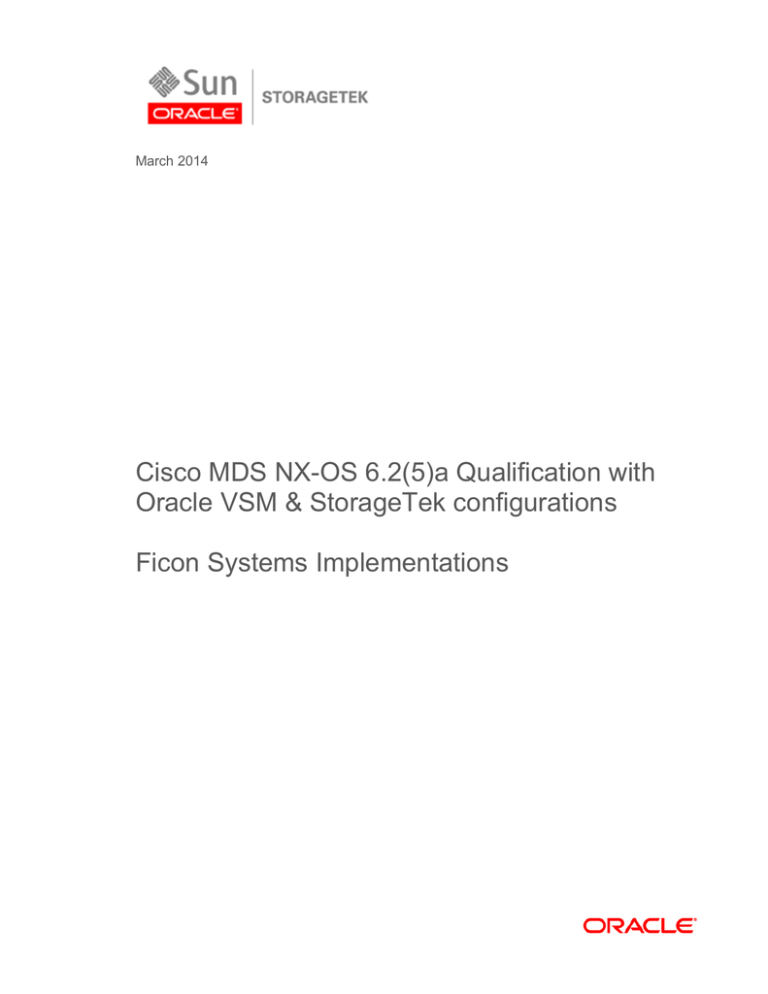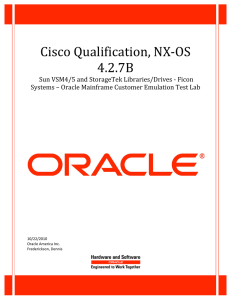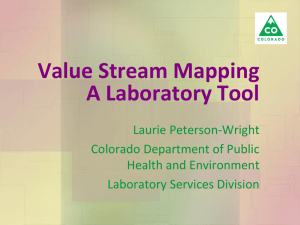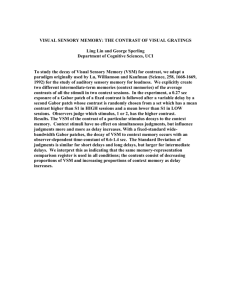
March 2014
Cisco MDS NX-OS 6.2(5)a Qualification with
Oracle VSM & StorageTek configurations
Ficon Systems Implementations
Cisco MDS NX-OS 6.2(5)a Qualification with Oracle VSM & StorageTek configurations
Introduction ....................................................................................... 1
Overview ........................................................................................... 2
Products and Software ...................................................................... 2
Configurations Tested ....................................................................... 3
Test Process and Results .................................................................. 4
Error Injection Testing ....................................................................... 4
Limitations ......................................................................................... 4
Status ................................................................................................ 5
Definitions ......................................................................................... 5
Qualification Information .................................................................... 5
Cisco MDS NX-OS 6.2(5)a Qualification with Oracle VSM & StorageTek configurations
Introduction
The purpose of this document is to provide certification information to personnel that would use
this as proof of configuration acceptance. The following information will include examples of
configurations with all equipment identified. Test reports will be provided if necessary but the
overall status will be provided. This document is not intended to be a standalone document. It
should be used with the associated documentation to implement a VSM-Cluster configuration
with Cisco switches/directors.
1
Overview
Cisco 18/4 and SSN-16 line cards are the hardware portion of the Cisco channel extension solution for the 9222i and 95xx
series switches. Cisco code version 6.2(5a) was tested for interoperability with the devices and microcode described in this
document.
Products and Software
Host Mainframe:
Host OS:
Application Software:
IBM Z10 with FICON Express8 channels
z/OS 1.13
IEBDG, IEBGENER, DFSMS/DSS Backup/Restore, FDR Backup/Restore,
SyncSort and DFSort
Library/VSM Control Software: ELS 7.1
Cisco 95xx: v6.2(5a)
StorageTek VSM4: D02.18.11.00 with VCF2 cards
StorageTek VSM5: D02.18.11.00 with VCF4 cards
StorageTek VSM6: 6.0.6.12.000
StorageTek 9840C: 1.46.503
StorageTek 9840D: 1.46.703
StorageTek T10000A: 1.50.103
StorageTek T10000B: 1.50.203
StorageTek T10000C: 1.61.301
StorageTek T10000D: 4.07.106
Distances emulated were 200km to 5000km. All testing was done using the GigE WAN interfaces connected through an
Anue Network Distance Emulator.
Cisco Systems MDS 9xxx series Switches/Directors with 18/4, SSN-16 and Supervisor 2(a) cards with NX-OS level
6.2(5a) installed.
2
Configurations Tested
Example configuration may not be exact to every customer configuration. This is used to identify what would benefit most
customers and understanding the testing of these general types of configurations.
z/OS
Processor
VSM Back-end RTD Extension
Cascaded Switches
(Anue)
distance
emulator
Cisco
95xx
9222i
Cisco
95xx
9222i
RTD’s
9840C,D
T10KA,B,C,D
Figure 1 – Native tape CHPID
z/OS
Processor
VSM Front-end Channel
Extension Cascaded Switches
(Anue)
Distance
emulator
Cisco
95xx
9222i
VSM
Cisco
95xx
9222i
RTD’s
9840C,D
T10KA,B,C,D
Figure 2 – VSM Front End CHPID
z/OS
Processor
VSM Back-end RTD Extension
Cascaded Switches
VSM
(Anue)
distance
emulator
Cisco
95xx
9222i
Cisco
95xx
9222i
RTD’s
9840C,D
T10KA,B,C,D
Figure 3 – VSM Back End RTD
z/OS
Processor
VSM CLINK Extension
Cascaded Switches
VSM4/5
Cisco
95xx
9222i
(Anue)
distance
emulator
Cisco
95xx
9222i
Figure 4 – VSM CLINK
3
VSM4/5
Test Process and Results
The Cisco 95xx was tested on the “front-end” of the VSM, the “back-end” (RTD communication) of the VSM, and as a
method of extending clustering CLINKs between a VSM5 and VSM4, and as a method of extending direct attach native
tape drives. The GigE ports on the 95xx were routed through an Anue Network Emulator to simulate the network
latency.
Testing consisted of mainframe jobs that read and wrote to VTDs (Virtual Tape Drives) or native drives using IEBDG and
IEBGENER, DFSMS/DSS Backup/Restore, FDR Backup/Restore, SyncSort and DFSort. Total run time for testing was
72 hours for each configuration tested.
Error Injection Testing
In addition, error injection testing was performed by disconnecting cables, GigE links, forcing Check-0 errors on the
VSM5 and VSM4, and disabling switch ports, to test error recovery of the solution. No abnormalities were found.
Expected results were seen after each disruption. After reestablishing connectivity, all connections recovered as expected.
Limitations
Testing is limited to interoperability testing, meaning the testing of whether hardware and software interoperate without
error under normal usage and under the errors injected as described.
What is not covered are:
Performance testing (whether performance would be acceptable under all circumstances)
Acceptable performance is a subjective judgment, and also highly dependent on the particular customer needs.
Suitability testing (whether the tested configuration are suitable for a particular customer)
The VSM solution can be configured in many different ways, and because of this the best suited solution for a particular
customer may not be any of the configurations tested.
Network error injection testing (whether real life network errors would cause problems)
The MCET test lab does not have the resources nor the expertise to test injection of errors into the communications
network between switches. It is left to the switch vendor to do such testing.
No performance measurements were taken. Because the VTSS can have switches located in-front (between mainframe
and VTSS), in back (between VTSS and RTDs) and on a CLINK (between two VTSS’s), there are many possible
configurations.
4
Status
All testing met expectations and status is PASS.
Definitions
“Front-end” means Z10 Host CHPID to VSM VCF card.
“Back-end” means VSM VCF card to a Real Tape Drive (RTD).
“CLINK” means VSM VCF card to VSM VCF card (Cluster).
“Native tape” means that the physical tape drives are run directly from the mainframe channel.
Qualification Information
Qualified by: Malcolm MacAskill
Lab: Mainframe Customer Emulation Test (MCET)
Date: March 18, 2014
Cisco MDS NX-OS 6.2.5a Qualification with
Copyright © 2013, Oracle and/or its affiliates. All rights reserved.
Oracle and StorageTek configruations
March 2014
This document is provided for information purposes only, and the contents hereof are subject to change without notice. This
Author: Dennis Frederickson
document is not warranted to be error-free, nor subject to any other warranties or conditions, whether expressed orally or implied in
Contributing Authors: Malcolm MacAskill
law, including implied warranties and conditions of merchantability or fitness for a particular purpose. We specifically disclaim any
Oracle Corporation
World Headquarters
500 Oracle Parkway
Redwood Shores, CA 94065
U.S.A.
liability with respect to this document, and no contractual obligations are formed either directly or indirectly by this document. This
document may not be reproduced or transmitted in any form or by any means, electronic or mechanical, for any purpose, without our
prior written permission.
Oracle and Java are registered trademarks of Oracle and/or its affiliates. Other names may be trademarks of their respective owners.
Worldwide Inquiries:
Intel and Intel Xeon are trademarks or registered trademarks of Intel Corporation. All SPARC trademarks are used under license and
Phone: +1.650.506.7000
are trademarks or registered trademarks of SPARC International, Inc. AMD, Opteron, the AMD logo, and the AMD Opteron logo are
Fax: +1.650.506.7200
trademarks or registered trademarks of Advanced Micro Devices. UNIX is a registered trademark of The Open Group. 0314
oracle.com
5






